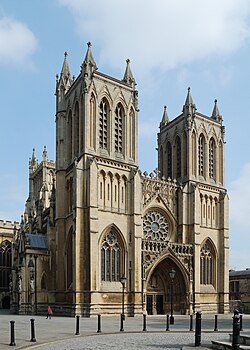Bristol Cathedral
| Bristol Cathedral | |
|---|---|
| Cathedral Church of the Holy and Undivided Trinity | |

The west front of Bristol Cathedral
|
|
| Coordinates: 51°27′06″N 2°36′03″W / 51.4517°N 2.6007°W | |
| Location | Bristol |
| Country | England |
| Denomination | Church of England |
| Website | bristol-cathedral.co.uk |
| History | |
| Consecrated | 11 April 1148 |
| Architecture | |
| Heritage designation | Grade I listed building |
| Designated | 8 January 1959 |
| Style | Norman, Gothic, Gothic Revival |
| Years built | 1220–1877 |
| Specifications | |
| Length | 300 feet (91 m) |
| Nave length | 125 feet (38 m) |
| Width across transepts | 29 feet (8.8 m) |
| Nave height | 52 feet (16 m) |
| Choir height | 50 feet (15 m) |
| Administration | |
| Diocese |
Worcester (until 1541) Gloucester (1541–43) Bristol (1543–1836) Gloucester and Bristol (1836–1897) Bristol (1897–present) |
| Province | Canterbury |
| Clergy | |
| Bishop(s) | Mike Hill |
| Dean | David Hoyle |
| Precentor | Nicola Stanley |
| Canon(s) | Robert Bull, Canon Pastor; Martin Gainsborough, Canon Theologian |
| Laity | |
| Organist(s) | Mark Lee |
Bristol Cathedral, formally the Cathedral Church of the Holy and Undivided Trinity, is the Church of England cathedral in the city of Bristol, England. Founded in 1140 and consecrated in 1148, it was originally St Augustine's Abbey but after the Dissolution of the Monasteries it became in 1542 the seat of the newly created Bishop of Bristol and the cathedral of the new Diocese of Bristol. It is a Grade I listed building.
The eastern end of the church includes fabric from the 12th century, with the Elder Lady Chapel which was added in the early 13th century. Much of the church was rebuilt in the English Decorated Gothic style during the 14th century despite financial problems within the abbey. In the 15th century the transept and central tower were added. The nave was incomplete at the Dissolution of the Monasteries in 1539 and was demolished. In the 19th century Gothic Revival a new nave was built by George Edmund Street partially using the original plans. The western twin towers, designed by John Loughborough Pearson, were completed in 1888.
Located on College Green, the cathedral has tall Gothic windows and pinnacled skyline. The eastern end is a hall church in which the aisles are the same height as the Choir and share the Lierne vaults. The late Norman chapter house, situated south of the transept, contains some of the first uses of pointed arches in England. In addition to the cathedral's architectural features, it contains several memorials and an historic organ. Little of the original stained glass remains with some being replaced in the Victorian era and further losses during the Bristol Blitz.
...
Wikipedia

